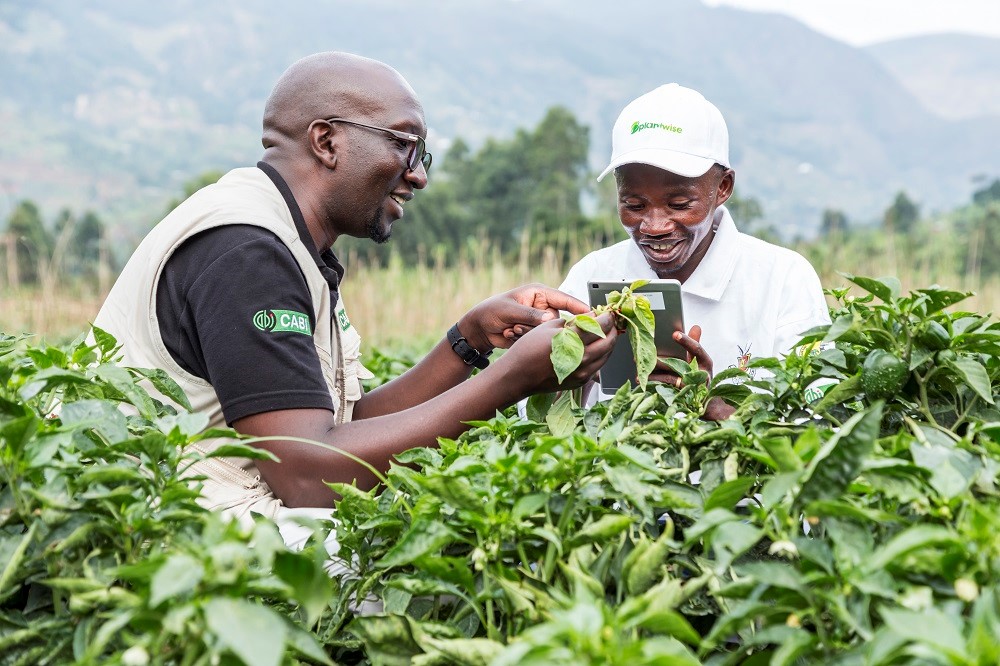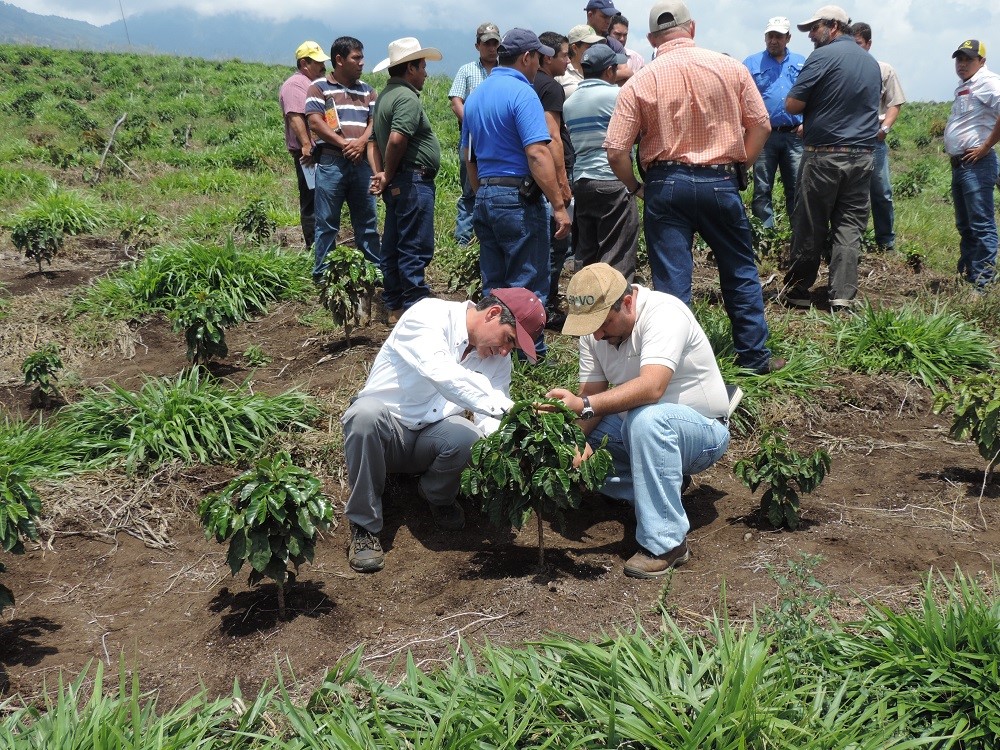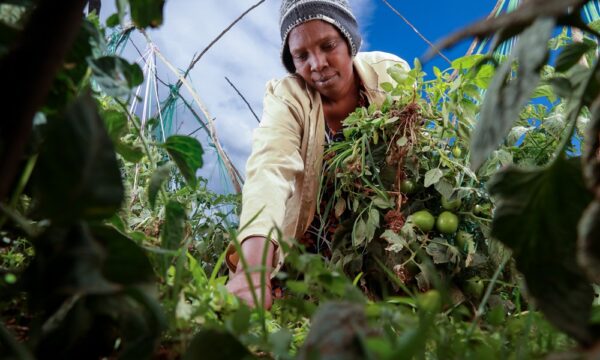
Following Earth Day on 22 April, CABI’s Executive Director, Global Operations, Dr Ulrich Kuhlmann, looks at two fundamental ways in which smallholders can be empowered to build resilience to climate change – access to better evidence-based agricultural information and a more concerted approach by governments in relation to investment and knowledge sharing.
When it comes to climate change, the agricultural sector faces a double-edged dilemma. It is one of the world’s biggest contributors to greenhouse gas emissions, but it is also one of the most vulnerable sectors to the impacts of climate change. Given the fundamental role that agriculture plays in our lives, it is imperative that we take bold steps to mitigate the sector’s impact on the environment while safeguarding it from the worst effects of global warming.
The sobering reality is that the future of global food security rests on our ability to address the looming climate crisis. According to the Intergovernmental Panel on Climate Change (IPCC), if global temperatures rise beyond 1.5°C, food security risks will increase ten-fold, pushing 80 million people into severe hunger by 2050. The evidence is particularly stark for Africa, where agricultural productivity has already dropped by 34% since the 1960s due to climate change – more than any other region. And if temperatures rise to 3°C, as current projections suggest, staple crops such as maize will become unsuitable to grow, leading to even greater food insecurity. In 2022, the UN reported that as many as 828 million people are affected by hunger worldwide.
The impact of climate change on the world’s 500 million smallholders cannot be overstated. These individuals, mainly from low- and middle-income countries, face unprecedented challenges such as droughts, floods, and pest migrations. Despite the essential role they play in food security, they often lack access to reliable agricultural information and struggle to find evidence-based climate adaption solutions.
As we mark Earth Day, we must focus on investing in our planet by empowering smallholders with the knowledge, skills, and tools they need to adapt and thrive in the face of climate change. This means curating and disseminating accessible, evidence-based information to smallholders and investing in smallholder farming.
Putting accurate and reliable agricultural information in smallholders’ hands
Despite the wealth of data available about agriculture and the environment, major gaps remain. Further effort is needed to curate, synthesize and make accessible existing data and evidence in order to turn this into useful knowledge.
Many answers to climate adaptation exist. Take coffee production, for example. The coffee berry borer (CBB) pest (Hypothenemus hampei) has been devastating arabica coffee crops in Colombia for years and posing a dire threat to the livelihoods of smallholder farmers. Shockingly, 75% of coffee crops in Colombia are affected by CBB, resulting in over $US500 million worth of damage annually. The warmer and wetter conditions caused by climate change are ideal for CBB and have enabled the pest to spread rapidly to higher elevations.

However, research projects are gathering evidence-based data about the pest to give farmers the early-warning system they need when it starts to spread. Cafexport, an organization that supports coffee producers in Colombia, along with CABI scientists and other partners from the UK, have collected data from coffee fields using remote sensing technology and direct analysis with farmers. The research includes humidity, temperature, and pest numbers.
Combined with satellite data and historical climate trends, this information can be used to create an early warning system for CBB. The system helps farmers to identify the optimal time to apply biopesticides and reduce crop losses. By merging field and satellite data, the CBB alert tool can be scaled geographically and aid the development of climate-smart coffee farming practices.
The Woody Weeds+ project in East Africa is another good example of data gathering for evidence-based interventions. Pastoralist livelihoods in Kenya’s Baringo County have been greatly impacted by an invasion of woody weeds. For example, the invasive plant Prosopis juliflora has grown in area by over 2,000% in just 28 years in this region, causing native species to diminish. This growth has led to an 86% decline in grasslands – important ecosystems for sequestering carbon dioxide. Additionally, this thirsty weed exacerbates the effects of climate change by consuming up to half the total rainfall in certain arid regions of East Africa.
To address this challenge, CABI is leading the Woody Weeds+ project in Kenya. The project focuses on generating and sharing evidence-based knowledge about the impact and spread of woody weeds on landscapes, as well as developing sustainable land management strategies for controlling them. This project helps communities collectively tackle land degradation caused by invasive plants, helping to build local adaptive capacity and restore ecosystem services vital to coping with climate impacts. Inclusive governance approaches are fundamental to building this kind of resilience.
Governments play a pivotal role in agricultural climate adaptation
Governments can play a crucial role in providing support to those on the frontline of the climate crisis. By investing in smallholder value chains, they can secure the planet’s future while ensuring food security and preserving biodiversity. However, while governments have invested in certain areas of climate adaptation, agriculture has not been a priority.
In 2009, high-emitting, high-income countries pledged to provide a balanced funding approach to low-income countries for climate adaptation and mitigation actions, committing a minimum of US$100 billion per year by 2020. Moreover, they aimed to mobilize considerable climate finance from private sector sources. However, the balance of climate finance has been skewed towards mitigation actions in the energy, infrastructure, and transport sectors, which have received 95% of all climate finance to date.
Shockingly, a mere 0.1% of private climate finance has been allocated to adaptation in smallholder farming value chains. Additionally, the agriculture and land-use sectors have only been given 2% of climate-aligned bonds, the majority of which are concentrated on initiatives in the global north.
Initiatives like Commercial Agriculture for Smallholders and Agribusiness (CASA) are helping to turn this around. CABI leads the initiative’s research and engagement, the primary objective of which is to facilitate worldwide investment in climate-resilient, inclusive agri-food systems, thereby increasing smallholder incomes. In line with this goal, CABI has prioritized the mobilization of climate finance to adapt smallholder agriculture in the CASA programme.
Global programmes such as PlantwisePlus are also helping governments to bring scientifically proven agricultural information to smallholder farmers. With the support of national plant protection organizations, the programme enhances, for example, the use of low-risk plant protection solutions such as biopesticides. These natural alternatives to chemical pesticides are better not only for biodiversity and the environment, but also for human health.
Multi-stakeholder projects like the Pest Risk Information Service (PRISE) can also help to bring scientifically proven data to smallholders. PRISE is an early warning system that combines earth observation technology, pest models and real-time field observations to deliver tailored pest alerts and actionable advice to farmers. Based on environmental data, PRISE models the risk to crops from insect pests and plant diseases. Tailored messages are then created and made available through the Plantwise plant clinic network and other local extension services, giving clear advice on how and when to apply appropriate practices to minimize crop damage.
What action can governments take to help smallholders?
We believe governments can help smallholders in four ways. Firstly, they can support smallholder farmers and businesses with access to information and tools to assess climate risks and enhance their adaptive capacity. This means investing in the curation of information that is high quality, evidence-based and reliable. Secondly, as climate change increases pest migrations, governments can inform national and farm-level planning by developing pest and disease risk analytics that incorporate climate data.
Thirdly, governments can develop management and governance plans to control invasive species on a landscape scale, providing enhanced climate resilience and contributing to climate mitigation. It is important to see farming as part of the wider landscape when it comes to climate-smart agriculture. And finally, governments can explore cutting-edge areas of research to improve climate adaptation. Research is the key not only to understanding the nature and scale of the climate challenges facing us, but also the solutions we can take to address them.
Additional information
Main image: CABI is supporting smallholder farmers mitigate crop pests and diseases exacerbated by climate change using a suite of digital tools under the global PlantwisePlus programme (Credit: CABI).
Related News & Blogs
Biodiversity loss: How can we reclaim our landscapes from threats to biodiversity?
On 22nd May, we mark the International Day for Biological Diversity. In this article, CABI’s Global Director for Invasive Species Dr Hariet Hinz looks at how we can reclaim our landscapes from threats to biodiversity. Biodiversity loss is proceeding at…
22 May 2025




